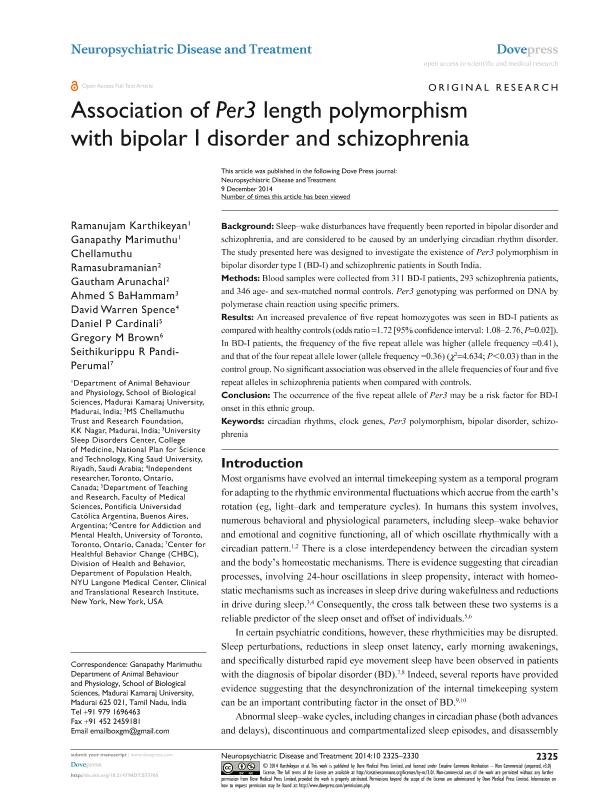Artículo
Association of Per3 length polymorphism with bipolar I disorder and schizophrenia
Karthikeyan, Ramanujam; Marimuthu, Ganapathy; Ramasubramanian, Chellamuthu; Arunachal, Gautham; BaHammam, Ahmed S.; Spence, David Warren; Cardinali, Daniel Pedro ; Brown, Gregory M.; Pandi Perumal, Seithikurippu R.
; Brown, Gregory M.; Pandi Perumal, Seithikurippu R.
 ; Brown, Gregory M.; Pandi Perumal, Seithikurippu R.
; Brown, Gregory M.; Pandi Perumal, Seithikurippu R.
Fecha de publicación:
12/2014
Editorial:
Dove Press
Revista:
Neuropsychiatric Disease and Treatment
ISSN:
1176-6328
Idioma:
Inglés
Tipo de recurso:
Artículo publicado
Clasificación temática:
Resumen
BACKGROUND: Sleep-wake disturbances have frequently been reported in bipolar disorder and schizophrenia, and are considered to be caused by an underlying circadian rhythm disorder. The study presented here was designed to investigate the existence of Per3 polymorphism in bipolar disorder type I (BD-I) and schizophrenic patients in South India. METHODS: Blood samples were collected from 311 BD-I patients, 293 schizophrenia patients, and 346 age- and sex-matched normal controls. Per3 genotyping was performed on DNA by polymerase chain reaction using specific primers. RESULTS: An increased prevalence of five repeat homozygotes was seen in BD-I patients as compared with healthy controls (odds ratio =1.72 [95% confidence interval: 1.08-2.76, P=0.02]). In BD-I patients, the frequency of the five repeat allele was higher (allele frequency =0.41), and that of the four repeat allele lower (allele frequency =0.36) (χ (2)=4.634; P<0.03) than in the control group. No significant association was observed in the allele frequencies of four and five repeat alleles in schizophrenia patients when compared with controls. CONCLUSION: The occurrence of the five repeat allele of Per3 may be a risk factor for BD-I onset in this ethnic group.
Archivos asociados
Licencia
Identificadores
Colecciones
Articulos(BIOMED)
Articulos de INSTITUTO DE INVESTIGACIONES BIOMEDICAS
Articulos de INSTITUTO DE INVESTIGACIONES BIOMEDICAS
Articulos(OCA HOUSSAY)
Articulos de OFICINA DE COORDINACION ADMINISTRATIVA HOUSSAY
Articulos de OFICINA DE COORDINACION ADMINISTRATIVA HOUSSAY
Citación
Karthikeyan, Ramanujam; Marimuthu, Ganapathy; Ramasubramanian, Chellamuthu; Arunachal, Gautham; BaHammam, Ahmed S.; et al.; Association of Per3 length polymorphism with bipolar I disorder and schizophrenia; Dove Press; Neuropsychiatric Disease and Treatment; 10; 12-2014; 2025-2330
Compartir
Altmétricas



